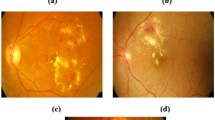Abstract
Diabetic retinopathy is a major cause of blindness in diabetic patients. It is an eye disease caused by diabetes mellitus which affects the retina. Recognition of the severity of this disease at early stage is a challenging factor for the ophthalmologists. In this article, a novel diagnosis system for identifying the severity of diabetic retinopathy is proposed using a multi level set segmentation algorithm and support vector machine with selective features along with genetic algorithm. The proposed system uses some mathematical morphological operations for clustering. After that the clusters are passed to the multi level set segmentation algorithm and some features are extracted using Local Binary Patterns as a texture descriptor for retinal images, color moments and statistical features such as mean, median etc. to detect the major regions of retina. Then the extracted features are given to the support vector machine classifier to classify the disease severity. This system was evaluated and compared using measures of sensitivity and specificity. We obtain sensitivity of 97.14%, specificity of 100% and accuracy of 99.3% on an average. From the seen results, it is observed that our proposed system is suited for the diagnosis of diabetic retinopathy at the early stage.









Similar content being viewed by others
References
Abbas Q, Fondon I, Sarmiento A, Jiménez S, Alemany P (2017) Automatic recognition of severity level for diagnosis of diabetic retinopathy using deep visual features. Med Biol Eng Comput 55:1959–1974
Acharya UR, Mookiah MR, Koh JEW, Tan JH, Noronha K, Bhandary SV, Rao AK, Hagiwara Y, Chua CK, Laude A (2016) Novel risk index for the identification of age-related macular degeneration using radon transform and DWT features. Comput Biol Med 73:131–140
Ahmad Fadzil MH, Izhar LI, Nugroho H, Nugroho HA (2011) Analysis of retinal fundus images for grading of diabetic retinopathy severity. Med Biol Eng Comput 49(6):693–700
Ahonen T, Hadid A, Pietikainen M (2006) Face description with local binary patterns: application to face recognition. IEEE Trans Pattern Anal Mach Intell 28(12):2037–2041
Aravind C, PonniBala M, Vijayachitra S (2013) Automatic detection of microaneurysms and classification of diabetic retinopathy images using SVM technique. In: IJCA, ICIIIOSP, pp 18–22
ARIA online (2006) Retinal image archive. http://www.eyecharity.com/aria online.html
Bhaskaranand M, Ramachandra C, Bhat S, Cuadros J, Nittala MG, Sadda SV, Solanki K (2016) Automated diabetic retinopathy screening and monitoring using retinal fundus image analysis. J Diabetes Sci Technol 10(2):254–261
Bhattacharjee R, Chakraborty M (2012) Exudates, retinal and statistical features detection from diabetic retinopathy and normal fundus images: an automated comparative approach. In: National Conference on Computing and Communication Systems (NCCCS)
Engelgau M, Geiss L, Saaddine J, Boyle J, Benjamin S, Gregg E, Tierney E, Rios-Burrows N, Mokdad A, Ford E, Imperatore G, Venkat Narayan KM (2004. Web. 22 Apr. 2014) The evolving diabetes burden in the United States. Ann Intern Med 140:945–950
Heikkil M, Pietikinen M, Schmid C (2009) Description of interest regions with local binary patterns. Pattern Recogn 42(3):425–436
Kandhasamy JP, Balamurali S (2015) Performance analysis of classifier models to predict diabetes mellitus. Prog Comput Sci 47:45–51
Krishnan MMR, Laude A (2013) An integrated diabetic retinopathy index for the diagnosis of retinopathy using digital fundus image features. Journal of Medical Imaging and Health Informatics (JMIHI) 3(2):306–313
Li B, Li HK (2013) Automated analysis of diabetic retinopathy images. Curr Diab Rep 13(4):453–459
Mishra PK, Sinha A, Teja KR, Bhojwani N, Sahu S, Kumar A (2014) A computational modelling for the detection of diabetic retinopathy severity. Bioinformation 10(9):556–561
Mookiah MR, Acharya UR, Chua CK, Lim CM, Ng EY, Laude A (2013a) Computer-aided diagnosis of diabetic retinopathy: a review. Comput Biol Med 43(12):2136–2155
Mookiah RKM, Chua CK, Min LC, Ng EYK, Laude A (2013b) Computer aided diagnosis of diabetic retinopathy using multi-resolution analysis and feature ranking frame work. Journal of Medical Imaging and Health Informatics (JMIHI) 3(4):598–606
Ojala T, Pietikinen M, Menp T (2001) A generalized local binary pattern operator for multiresolution gray scale and rotation invariant texture classification. In: 2nd international conference on advances in pattern recognition, pp 397–406
Ojala T, Pietikainen M, Maenpaa T (2002) Multiresolution gray-scale and rotation invariant texture classification with local binary patterns. IEEE Trans Pattern Anal Mach Intell 24(7):971–987
Paranjpe MJ, Kakatkar MN (2013) Automated diabetic retinopathy severity classification using support vector machine. International Journal for Research in Science Advanced Technologies (IJRSAT) 3(3):086–091
Prakash NB, Selvathi D, Hemalakshmi GR (2014) Development of algorithm for dual stage classification to estimate severity level of diabetic retinopathy in retinal images using soft computing techniques. International Journal on Electrical Engineering and Informatics (IJEEI) 6(4):717–739
Priya R, Aruna P (2013) Diagnosis of diabetic retinopathy using machine learning techniques. ICTACT Journals on Soft Computing 03(4):563–575
Verma K, Deep P, Ramakrishnan AG (2011) Detection and classification of diabetic retinopathy using retinal images. In: Proceeding of annual IEEE India conference (INDICON), pp 1–6
Washington RE, Orchard TJ, Arena VC, LaPorte RE, Secrest AM, Tull ES (2014) All-cause mortality in a population based type 1 diabetes cohort in the U.S. Virgin Islands. Diabetes Res Clin Pract 103(3):504–509
World Health Organization (WHO) (2010) Action plan for the prevention of avoidable blindness and visual impairment 2009-2013
World Health Organization (WHO) (2013) Universal eye health: a global action plan 2014-2019
Yun WL, Acharya UR, Venkatesh YV, Chee C, Min LC, Ng EYK (2008) Identification of different stages of diabetic retinopathy using retinal optical images. Inf Sci 178(1):106–121
Author information
Authors and Affiliations
Corresponding author
Additional information
Publisher’s note
Springer Nature remains neutral with regard to jurisdictional claims in published maps and institutional affiliations.
Rights and permissions
About this article
Cite this article
Kandhasamy, J.P., Balamurali, S., Kadry, S. et al. Diagnosis of diabetic retinopathy using multi level set segmentation algorithm with feature extraction using SVM with selective features. Multimed Tools Appl 79, 10581–10596 (2020). https://doi.org/10.1007/s11042-019-7485-8
Received:
Revised:
Accepted:
Published:
Issue Date:
DOI: https://doi.org/10.1007/s11042-019-7485-8




